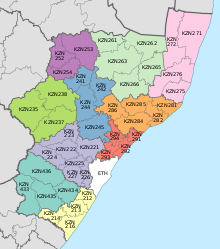Ulundi Local Municipality
Template:Infobox South African municipality Ulundi Local Municipality is a local municipality located on the southern boundary of the Zululand District Municipality in northeastern KwaZulu-Natal, South Africa. It is a mainly rural municipality that encompasses the town of Ulundi.
Population characteristics
Recent surveys have identified the following characteristics of the municipality's population:[1]
More than half the population is younger than 19 years of age, placing pressure on the need for social facilities. A significant number of these children will be orphaned due to HIV/AIDS.
At least 12% of the population (27 450 people) are already infected with HIV/AIDS. Population growth is expected to decline over the next 20 years.
Education levels are very low; 29% of the population has no formal education.
Income levels are very low; nearly 40% of households have no income. Unemployment levels are very high, with only 12.5% of the total population being formally employed.
The population is predominantly Zulu in ethnicity and culture.
Places of interest
The tourism potential of the area remains largely undeveloped; however, the area features a number of activities and places of interest. These include game reserves, historical/cultural sites, cultural events and guest lodges. Game reserves include the Hluhluwe-Umfolozi Parks, the Ophathe Game Park, the Emakhosini (Valley of the Zulu Kings), the planned Emakhosini-Ophathe Conservancy, and the ThakaZulu Game Reserve. Historical/cultural sites include Nodwengu (King Mpande’s residence and grave), Ulundi Battlefield, Amafa and Dingaan Stat/Piet Retief’s grave.
Main places
The 2001 census divided the municipality into the following main places:[2]
| Place | Code | Area (km2) | Population |
|---|---|---|---|
| Babanango | 53101 | 6.54 | 1,297 |
| Buthelezi Empithimpithini | 53102 | 464.49 | 49,553 |
| Inhlazatshe | 53103 | 13.60 | 1,214 |
| Kwazunyawo | 53104 | 5.91 | 1,298 |
| Mahlabatini | 53105 | 8.21 | 2,342 |
| Mbatha | 53106 | 124.05 | 9,954 |
| Mpungose | 53107 | 158.64 | 27,726 |
| Ndebele | 53108 | 93.44 | 14,799 |
| Nobamba | 53109 | 684.56 | 41,286 |
| Simelane | 53110 | 3.48 | 501 |
| Ulundi | 53111 | 10.27 | 18,420 |
| Ximba | 53112 | 298.34 | 19,330 |
| Zungu | 53113 | 321.98 | 17,228 |
| Remainder of the municipality | 53114 | 1,561.36 | 8,017 |
Politics
The municipal council consists of forty-seven members elected by mixed-member proportional representation. Twenty-four councillors are elected by first-past-the-post voting in twenty-four wards, while the remaining twenty-three are chosen from party lists so that the total number of party representatives is proportional to the number of votes received. In the election of 3 August 2016 the Inkatha Freedom Party (IFP) won a majority of thirty-five seats on the council. The following table shows the results of the election.[3][4]
style="width: 2px; background-color: #FF0000;" data-sort-value="Inkatha Freedom Party" | style="width: 2px; background-color: #006600;" data-sort-value="African National Congress" | style="width: 2px; background-color: #852A2A;" data-sort-value="Economic Freedom Fighters" | style="width: 2px; background-color: #005BA6;" data-sort-value="Democratic Alliance (South Africa)" | style="width: 2px; background-color: #DCDCDC;" data-sort-value="Independent (politics)" | style="width: 2px; background-color: lightgrey;" data-sort-value="Academic Congress Union" || Party | Votes | Seats | ||||||
|---|---|---|---|---|---|---|---|---|
| Ward | List | Total | % | Ward | List | Total | ||
| IFP | 40,494 | 41,283 | 81,777 | 73.1 | 24 | 11 | 35 | |
| ANC | 12,994 | 12,950 | 25,944 | 23.2 | 0 | 11 | 11 | |
| EFF | 999 | 963 | 1,962 | 1.8 | 0 | 1 | 1 | |
| DA | 550 | 521 | 1,071 | 1.0 | 0 | 0 | 0 | |
| Independent | 558 | – | 558 | 0.5 | 0 | – | 0 | |
| Academic Congress Union | 325 | 192 | 517 | 0.5 | 0 | 0 | 0 | |
| Total | 55,920 | 55,909 | 111,829 | 100.0 | 24 | 23 | 47 | |
| Spoilt votes | 627 | 562 | 1,189 | |||||
References
- ^ Integrated Development Plan 2006/2007 to 2011/2012 — June 2009. Ulundi Local Municipality. Retrieved on Oct 11, 2009.
- ^ Lookup Tables - Statistics South Africa
- ^ "Results Summary – All Ballots: Ulundi" (PDF). Independent Electoral Commission. Retrieved 9 January 2017.
- ^ "Seat Calculation Detail: Ulundi" (PDF). Independent Electoral Commission. Retrieved 9 January 2017.

